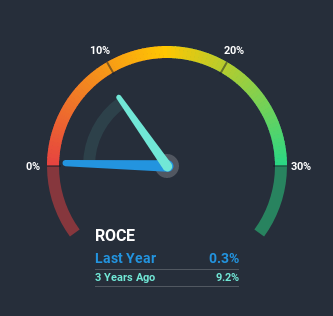- Japan
- /
- Specialty Stores
- /
- TSE:3174
Happiness and D (TYO:3174) Could Be At Risk Of Shrinking As A Company

Ignoring the stock price of a company, what are the underlying trends that tell us a business is past the growth phase? When we see a declining return on capital employed (ROCE) in conjunction with a declining base of capital employed, that's often how a mature business shows signs of aging. Ultimately this means that the company is earning less per dollar invested and on top of that, it's shrinking its base of capital employed. On that note, looking into Happiness and D (TYO:3174), we weren't too upbeat about how things were going.
Return On Capital Employed (ROCE): What is it?
For those that aren't sure what ROCE is, it measures the amount of pre-tax profits a company can generate from the capital employed in its business. To calculate this metric for Happiness and D, this is the formula:
Return on Capital Employed = Earnings Before Interest and Tax (EBIT) ÷ (Total Assets - Current Liabilities)
0.0027 = JP¥17m ÷ (JP¥11b - JP¥4.5b) (Based on the trailing twelve months to February 2021).
Therefore, Happiness and D has an ROCE of 0.3%. Ultimately, that's a low return and it under-performs the Specialty Retail industry average of 9.3%.
View our latest analysis for Happiness and D

While the past is not representative of the future, it can be helpful to know how a company has performed historically, which is why we have this chart above. If you'd like to look at how Happiness and D has performed in the past in other metrics, you can view this free graph of past earnings, revenue and cash flow.
So How Is Happiness and D's ROCE Trending?
There is reason to be cautious about Happiness and D, given the returns are trending downwards. To be more specific, the ROCE was 3.3% five years ago, but since then it has dropped noticeably. And on the capital employed front, the business is utilizing roughly the same amount of capital as it was back then. This combination can be indicative of a mature business that still has areas to deploy capital, but the returns received aren't as high due potentially to new competition or smaller margins. If these trends continue, we wouldn't expect Happiness and D to turn into a multi-bagger.
On a separate but related note, it's important to know that Happiness and D has a current liabilities to total assets ratio of 42%, which we'd consider pretty high. This effectively means that suppliers (or short-term creditors) are funding a large portion of the business, so just be aware that this can introduce some elements of risk. While it's not necessarily a bad thing, it can be beneficial if this ratio is lower.
The Key Takeaway
In the end, the trend of lower returns on the same amount of capital isn't typically an indication that we're looking at a growth stock. However the stock has delivered a 42% return to shareholders over the last five years, so investors might be expecting the trends to turn around. In any case, the current underlying trends don't bode well for long term performance so unless they reverse, we'd start looking elsewhere.
If you want to know some of the risks facing Happiness and D we've found 4 warning signs (2 make us uncomfortable!) that you should be aware of before investing here.
While Happiness and D isn't earning the highest return, check out this free list of companies that are earning high returns on equity with solid balance sheets.
When trading Happiness and D or any other investment, use the platform considered by many to be the Professional's Gateway to the Worlds Market, Interactive Brokers. You get the lowest-cost* trading on stocks, options, futures, forex, bonds and funds worldwide from a single integrated account. Promoted
Valuation is complex, but we're here to simplify it.
Discover if Happiness and DLtd might be undervalued or overvalued with our detailed analysis, featuring fair value estimates, potential risks, dividends, insider trades, and its financial condition.
Access Free AnalysisThis article by Simply Wall St is general in nature. It does not constitute a recommendation to buy or sell any stock, and does not take account of your objectives, or your financial situation. We aim to bring you long-term focused analysis driven by fundamental data. Note that our analysis may not factor in the latest price-sensitive company announcements or qualitative material. Simply Wall St has no position in any stocks mentioned.
*Interactive Brokers Rated Lowest Cost Broker by StockBrokers.com Annual Online Review 2020
Have feedback on this article? Concerned about the content? Get in touch with us directly. Alternatively, email editorial-team (at) simplywallst.com.
About TSE:3174
Happiness and DLtd
Operates and manages select shops under Happiness and GINZA Happiness names in shopping centers in Japan.
Good value with adequate balance sheet.
Market Insights
Community Narratives





